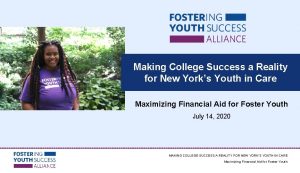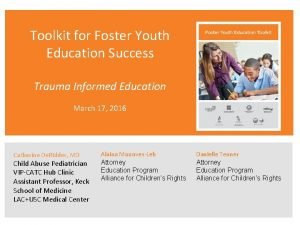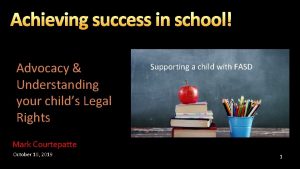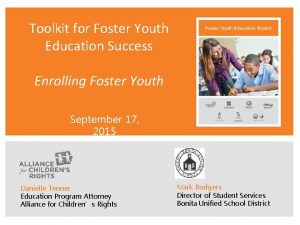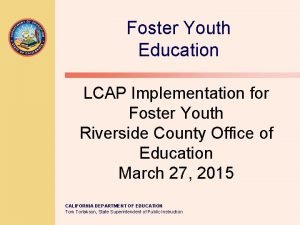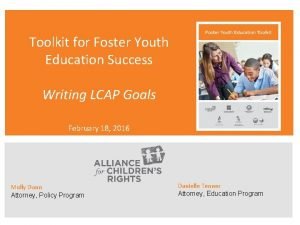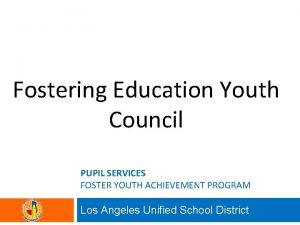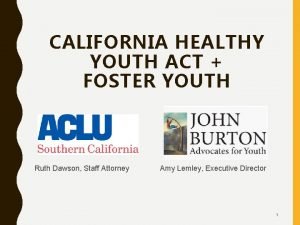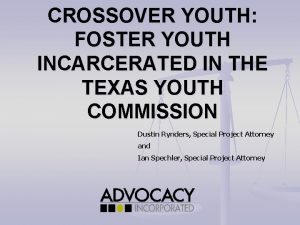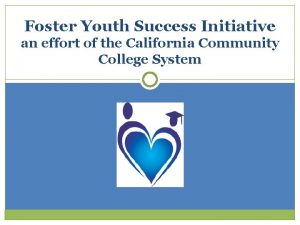Toolkit for Foster Youth Education Success Partial Credit















- Slides: 15

Toolkit for Foster Youth Education Success Partial Credit Model Policy October 15, 2015 Alaina Moonves-Leb Education Program Attorney Alliance for Children’s Rights David Ambroz Executive Director, Corporate Citizenship & Social Responsibility Disney/ABC Television

Technical Details § Call-in number is +1 (951) 384 -3421 and access code is 665 -661 -598 § To submit questions, click on your “Questions” panel, type your question and click “send” § Presentation materials and the Foster Youth Education Toolkit can be found at: kids-alliance. org/edtoolkit

Why are you here? You’ll Learn: 1. Why Partial Credits are So Important in Meeting the Needs of Foster Youth 2. How to Issue and Accept Partial Credits for Foster Youth NOTE: When we refer to foster youth, that includes both foster youth with open dependency court cases and probation youth with open delinquency court cases.

Partial Credit Youth Video

Frequently Asked Questions Why half credit increments? • High numbers of school transfers • Motivates and rewards foster youth for work, even if only placed for a short time • Helps with credit accumulation, increasing the odds of on-time graduation

Frequently Asked Questions Why does the model policy use the scale of awarding 1 credit per 14 class periods? • Balance between two competing concerns • Requires attendance at an adequate number of classes to earn a full grading period of credits (70/90 days) • Prevents penalizing lapses in attendance caused by delays in enrollment and attendance at court appearances or court ordered activities

Frequently Asked Questions Why is the model policy based on seat-time? • The law requires it! (Education Code Sections 49069. 5 and 51225. 2) • Must demonstrate competence/receive a passing grade • Difficulties of testing subject mastery

Frequently Asked Questions What about alternative schools? • Continuation schools, independent study programs, or adult schools • Approved credit plans (Education Code Section 51225. 3(b)) • If not, must have a policy (can use PCMP)

Frequently Asked Questions • What if my school uses block scheduling? • Class periods lasting 89 minutes or less count as 1 class period • Class periods lasting 90 minutes or more count as two class periods

Frequently Asked Questions • If a school district has not yet adopted this model policy, can a registrar/counselor still use these guidelines? • Yes • Schools have a legal obligation to calculate, issue, and accept partial credits, even if their school district boards have not yet adopted a partial credit policy

Frequently Asked Questions • Can receiving schools require youth to complete additional assignments to make up for missed coursework when they transfer into a school? • No • Penalizes youth based on their foster care status • Provide youth with tutoring and support to catch up in their classes

Frequently Asked Questions • If the school district’s Student Information System does not allow for the input of partial credits on an official transcript, can a registrar/counselor compensate a foster youth by encouraging them to graduate under AB 167/216 instead? • No • Every school has a legal responsibility to issue and accept partial credits for foster youth when they transfer • Only an Education Rights Holder may decide whether a student should graduate under AB 167/216. Foster youth must be given an equal opportunity to satisfy graduation requirements.

Why Are Partial Credits So Important? David Ambroz

Why Are Partial Credits So Important?

Questions? Contact us Alaina Moonves-Leb Education Program Attorney a. moonves@kids-alliance. org 213. 368. 6010 David Ambroz Executive Director, Corporate Citizenship & Social Responsibility Disney/ABC Television david. ambroz@disney. com
 Foster youth college success initiative
Foster youth college success initiative Trauma informed care for foster youth
Trauma informed care for foster youth Your child's success or lack of success
Your child's success or lack of success Your child's success or lack of success
Your child's success or lack of success This can be avoided by giving credit where credit is due.
This can be avoided by giving credit where credit is due. Education scotland play pedagogy toolkit
Education scotland play pedagogy toolkit Financial education services testimonials
Financial education services testimonials Iso 22301 utbildning
Iso 22301 utbildning Novell typiska drag
Novell typiska drag Tack för att ni lyssnade bild
Tack för att ni lyssnade bild Returpilarna
Returpilarna Varför kallas perioden 1918-1939 för mellankrigstiden
Varför kallas perioden 1918-1939 för mellankrigstiden En lathund för arbete med kontinuitetshantering
En lathund för arbete med kontinuitetshantering Kassaregister ideell förening
Kassaregister ideell förening Personlig tidbok fylla i
Personlig tidbok fylla i A gastrica
A gastrica
